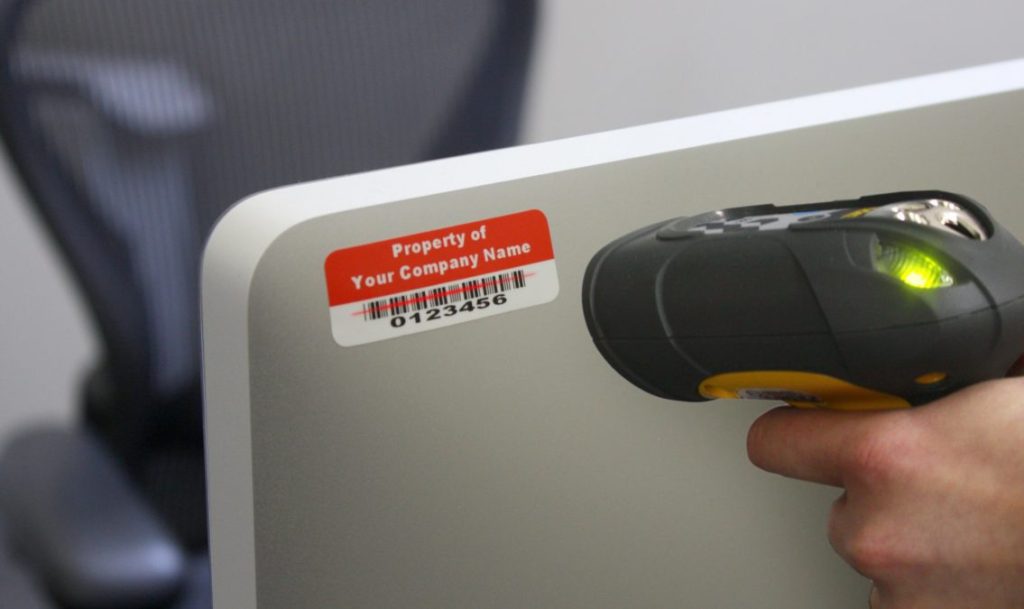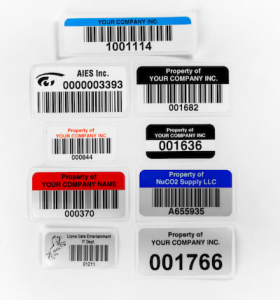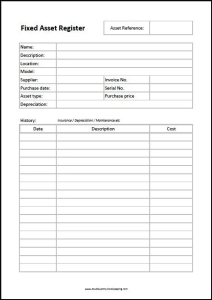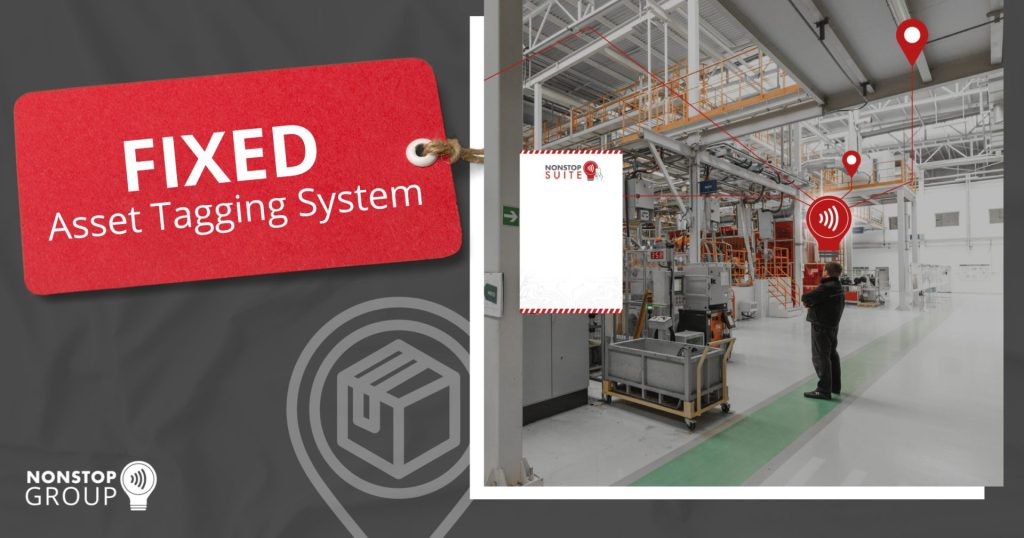6 Min Read
The need for a streamlined approach to managing assets cannot be overstated. Assets help businesses generate revenues & profits and form the background of operational efficiency. Businesses that own fixed assets, including machinery, furniture, or computer hardware, strive for optimal utilization, security, and longevity of these assets. Most businesses rely on an efficient, fixed asset tracking system that streamlines the way businesses track, monitor, and manage their valuable assets.

What Is Fixed Asset Tagging?
Fixed asset tagging refers to the systematic process leveraged by businesses to identify and track their assets throughout their lifecycle effectively. An asset tag helps businesses enhance control, efficiency, and accountability of assets.
The asset tagging process involves applying physical tags to individual assets with a unique identification number or label, typically in the form of barcodes, QR codes, or Radio-Frequency Identification (RFID) tags.
Depending on the asset type, businesses use different types of asset tags, including barcode tags, QR Code tags, RFID tags, tamper-evident tags, GPS-enabled asset tags, and color-coded tags. Each tag carries a distinct code or information that facilitates easy & accurate tracking, allowing businesses to monitor the location, usage, and condition of each asset.

Examples Of Fixed Assets for Asset Tagging
An array of fixed and moveable assets can leverage asset tags for enhanced asset management. Here are some examples of fixed assets that are commonly tagged for effective
1. Machinery & Equipment
Heavy machinery, manufacturing equipment, and other mechanical tools are important fixed assets subject to frequent wear and tear. Tagging these assets ensures their efficient use, timely maintenance, and accurate depreciation tracking.
2. Furniture and Office Equipment
Applying asset tags on office equipment, including desks, chairs, computers, and printers, aids managers in ensuring optimal usage of these resources. It also assists them in asset inventory management and facilitating an optimized work environment
3. Vehicles
Companies deploy several vehicles for transporting people and cargo. Tagging these assets can help businesses monitor vehicle location, track maintenance history, and prevent unauthorized use.

4. Building & Real Estate
Real property, including office buildings, warehouses, and manufacturing facilities, is a substantial fixed asset. Asset tagging assists in property management, maintenance planning, and compliance with regulations.
5. IT Infrastructure
IT infrastructure, including servers, routers, switches, and computer components, are critical assets for organizations. An effective asset tagging system can ensure efficient IT asset management and cybersecurity measures.
Smarter Asset Tracking With NFC Tags
Learn more about how NonStop Suite's NFC Asset Tracking Solution can help your Enterprise streamline operations to new heights.
Get A Free Product Tour
Why is Tagging of Fixed Assets Important?
Tagging of fixed assets is not just a procedural formality; it serves as a linchpin in the effective management and optimization of a company’s resources.
Here are some compelling reasons why tagging of fixed assets is crucial:
- Asset Identification and Tracking: Asset tagging provides a unique identifier for each fixed asset, enabling managers to identify assets swiftly and accurately. This is especially critical in large organizations with extensive inventories, preventing confusion and mismanagement.
- Preventing Loss and Theft: A tagging system acts as a deterrent against loss or theft. The visibility and traceability offered by asset tracking software make it challenging for unauthorized individuals to misuse or remove valuable assets.
- Accurate Record-Keeping: Fixed asset tags contribute to meticulous asset management. The accuracy of record-keeping is vital for financial reporting, compliance with regulations, and internal audits, ensuring that the organization’s financial statements reflect the true value of its assets.
- Facilitating Maintenance Management: When high-value assets are tagged, organizations can implement proactive maintenance schedules. This not only extends the lifespan of assets but also minimizes unexpected downtime, increases asset visibility, and optimizes operational efficiency.
- Improving Accountability: Asset tagging fosters a sense of accountability among employees. When assets are clearly labeled and tracked, individuals are more likely to adhere to proper usage and care guidelines. This ensures proper asset utilization.
- Effective Planning and Decision-Making: Asset tags provide historical records of asset usage and maintenance. This data is instrumental in making informed decisions about future investments, upgrades, or changes in asset portfolios.
What is the process of Tagging Assets?
Effective asset tagging involves careful planning, precise execution, and ongoing asset management. Here’s a step-by-step guide to the asset tagging process:
Categorize the Asset Type And Category
Begin by categorizing assets based on their type and category. This step lays the foundation for a structured and organized tagging system. For example, categorize similar physical assets, such as machinery, furniture, equipment, and vehicles.
Allocate a Distinctive Identification Number
Assign a unique ID number to each asset. This could be a serial number, a combination of letters and numbers, or any other alphanumeric code. Unique serial numbers create a distinct identifier that facilitates easy and accurate asset tracking.

Specify the Appropriate Asset Label Needed
Choose the type of asset labels that best suit the nature of the asset and the environment in which it operates. For instance, offices must use durable labels that withstand harsh environments and environmental conditions such as extreme temperatures, storms, and rain, while QR codes might be suitable for office equipment such as printers, telephones, etc.
Record the Asset’s Details and All Related Information in Your Asset Tracking System
Enter comprehensive details about each asset into the asset tracking system. The data collection process must include recording important data such as purchase date, cost, asset location, maintenance history, and any other relevant data. This step ensures a centralized repository of information for efficient management.
Attach the Asset Tags to the Items Securely
Affix the chosen asset tag type securely to the right equipment and assets. Ensure that the tags are prominently visible and the attachment method is durable. For metal assets, use tags designed to adhere to or withstand metal surfaces. Proper attachment is crucial for the longevity and effectiveness of the tagging system.
Establish Procedures for Data Verification
Implement robust procedures for data verification to maintain the accuracy of the asset tracking system. Regularly conduct audits and inspections to verify that the information in the system aligns with the physical presence and condition of the assets. This process helps identify discrepancies promptly.
What is an Asset Register?
In simple words, an asset register is a comprehensive database that contains records and essential details about an organization’s assets.

The primary purpose of an asset register is to provide a systematic and organized way to track and manage assets throughout their lifecycle. This includes asset acquisition, depreciation, maintenance, and eventual disposal of assets.
An accurately maintained asset register can help businesses make informed decisions regarding resource budgeting, allocation, and strategic planning.
Key benefits of an asset register include:
- Accurate depreciation calculation and precise budgeting support.
- Real-time location tracking of assets.
- Optimal resource allocation and informed decisions for accounting purposes.
- Comprehensive audit trail creation for compliance purposes.
- Mitigating risk by Facilitating preventive maintenance.
- Help businesses reduce costs by efficient management of asset lifespan.
- Prevent theft and enhance transparency through clear reporting.
Types of Asset Register
- Fixed Asset Registersfocus on tangible, long-term assets such as buildings, machinery, vehicles, and equipment. These registers mostly track acquisition costs, depreciation, and current values.
- Intangible Asset Registerstrack the acquisition, amortization, and valuation of non-physical assets like patents, copyrights, trademarks, and intellectual property.
- IT Asset Registersmanage IT assets such as computers, software licenses, servers, and networking equipment and consist of software versions, licenses, and maintenance schedules.
- Facilities Asset Registersrecord asset information related to facilities, including office spaces, furniture, and fixtures. These registers track facility maintenance upgrades and space allocations.
- An Information Asset Registerincludes data, databases, documents, and other digital information resources of an organization’s information-related assets. The register tracks the classification, sensitivity, access controls, and usage patterns of information assets.
- Digital Asset Registersare designed to catalog and manage digital assets, which can range from multimedia files, graphics, and design elements to software applications and digital marketing materials. This register assists in organizing and tracking licenses, usage rights, and version control of digital assets.
- Hardware Asset Registerstrack and record details like purchase information, configurations, maintenance schedules, and locations of hardware assets. It helps optimize the utilization of hardware, plan for upgrades, and ensure that the organization has the necessary equipment to support its operations.
Benefits of Fixed Asset Tagging Systems
Implementing a robust asset tagging system offers multifaceted benefits to businesses. One of the many benefits of asset tagging systems is that it facilitates proactive maintenance scheduling, which enhances asset management. The strategic integration of asset tags has become a cornerstone for efficient operational management, financial accuracy, and enhanced security.
With a well-designed asset tagging system, businesses gain unparalleled visibility into the location, usage patterns, and condition of their fixed assets. Businesses can leverage asset tags and an efficient asset tracking system for not only facilitating loss prevention but also promoting efficient resource allocation and decision-making.
If you are looking to seamlessly track assets with the help of a robust asset tagging system, get in touch with The NonStop Group (NSG). The NonStop Suite by NSG comes with a number of asset tagging features that can enable businesses to revolutionize how they manage assets and reduce asset downtime.
Learn more.

